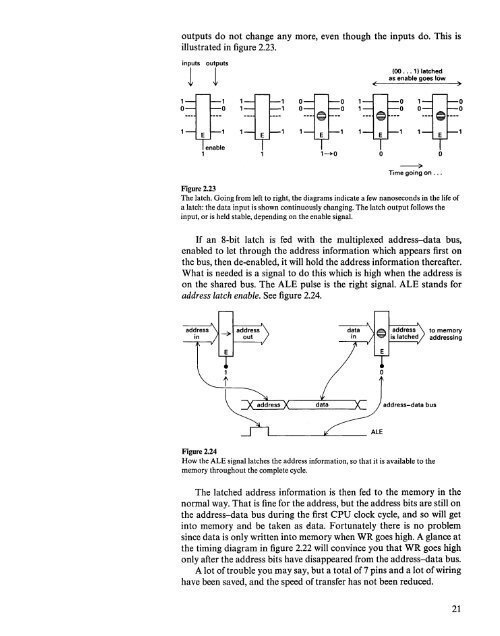Microcomputer Circuits and Processes
Microcomputer Circuits and Processes
Microcomputer Circuits and Processes
Create successful ePaper yourself
Turn your PDF publications into a flip-book with our unique Google optimized e-Paper software.
outputs do not change any more, even though the inputs do. This is<br />
illustrated in figure 2.23.<br />
T' our<br />
6~__<br />
___6<br />
1 E 1<br />
~*~ :*~*~<br />
(00... 1) latched<br />
as enable goes low<br />
(<br />
)<br />
:=fl=: ,-y-' ,-y-, ,-y-, ,-y-,<br />
enable<br />
1<br />
1 1-+0 0 0<br />
~<br />
Time going on ...<br />
Figure 2.23<br />
The latch. Going from left to right, the diagrams indicate a few nanoseconds in the life of<br />
a latch: the data input is shown continuously changing. The latch output follows the<br />
input, or is held stable, depending on the enable signal.<br />
If an 8-bit latch is fed with the multiplexed address-data bus,<br />
enabled to let through the address information which appears first on<br />
the bus, then de-enabled, it will hold the address information thereafter.<br />
What is needed is a signal to do this which is high when the address is<br />
on the shared bus. The ALE pulse is the right signal. ALE st<strong>and</strong>s for<br />
address latch enable. See figure 2.24.<br />
to memory<br />
addressing<br />
o<br />
address-data<br />
bus<br />
Figure 2.24<br />
How the ALE signal latches the address information, so that it is available to the<br />
memory throughout the complete cycle.<br />
The latched address information is then fed to the memory in the<br />
normal way. That is fine for the address, but the address bits are still on<br />
the address-data bus during the first CPU clock cycle, <strong>and</strong> so will get<br />
into memory <strong>and</strong> be taken as clata. Fortunately there is no problem<br />
since data is only written into memory when WR goes high. A glance at<br />
the timing diagram in figure 2.22 will convince you that WR goes high<br />
only after the address bits have disappeared from the address-data bus.<br />
A lot of trouble you may say, but a total of7 pins <strong>and</strong> a lot of wiring<br />
have been saved, <strong>and</strong> the speed of transfer has not been reduced.<br />
21











